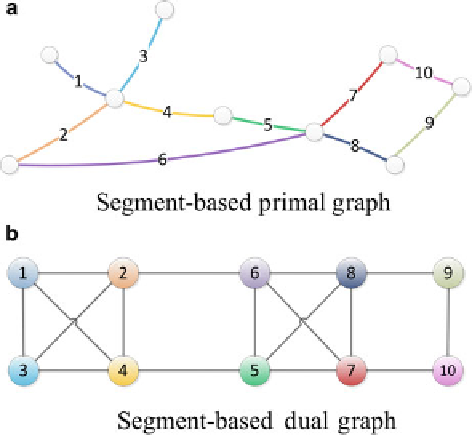Geography Reference
In-Depth Information
Fig. 8.1
Segment-based road
network
8.2.2
Stroke Based Dual Graph
A stroke is defined as a linear geographic entity that stretches in two dimensional
spaces. Named roads are more difficult to implement due to missing or wrong road
segment names. Previous research proved that stroke can overcome this shortage
and provide a natural way to represent self-organized natural road (Jiang
2007
).
Different from segment based network, the stroke is not fractured by junctions. In
this article, we generate the stroke from road segments using an enhanced stroke
generating algorithm originated from every-best fit algorithm proposed by (Jiang
et al.
2008
). In our algorithm, not only the angle of the two segments is considered,
the grade of the segments is used as well. That means even the angle between
two segments is acceptable, segments with different grade cannot be connected.
After generating the strokes, we use the stroke based dual graph as the second
representation of urban stroke networks where the strokes map to nodes and the
intersection between strokes map to edges between nodes. A caricature urban road
network shown in Fig.
8.2
presents an example of generating procedure of a stroke
based dual graph.
In Fig.
8.2
a, road segments are generated into strokes based on their angle and
grade. The dual graph of stroke-based urban road network is shown in Fig.
8.2
b
where nodes are strokes and edges are the corresponded connections. Stroke-based
graph in Fig.
8.2
show a different structure with segment-based graph in Fig.
8.1
.
For example, none of these strokes can cause the network split into pieces. But if
we delete stroke A or F, the route choices for vehicles are reduced. The damage can
also affect urban road network robustness. This indicates that robustness analysis
using stroke-based graph can be different from that using segment-based graph.

Search WWH ::

Custom Search